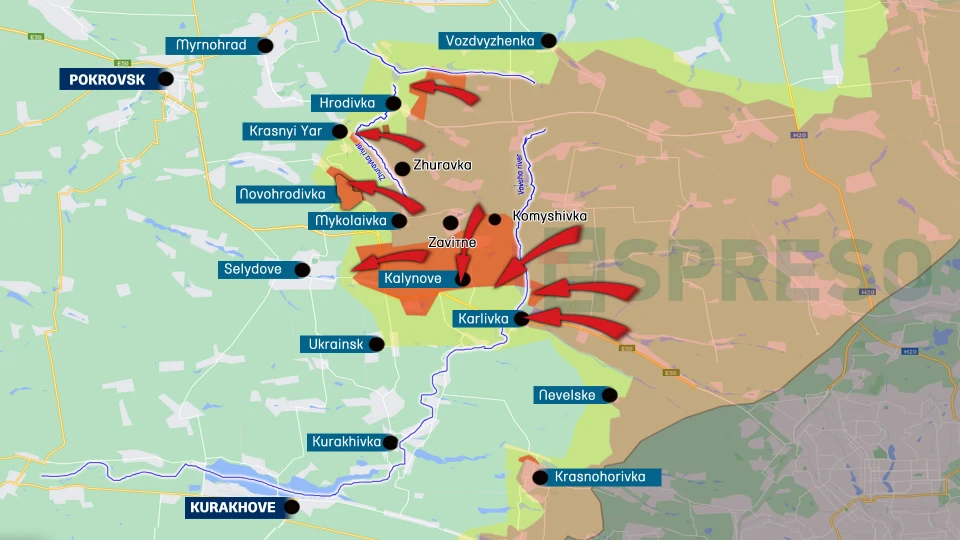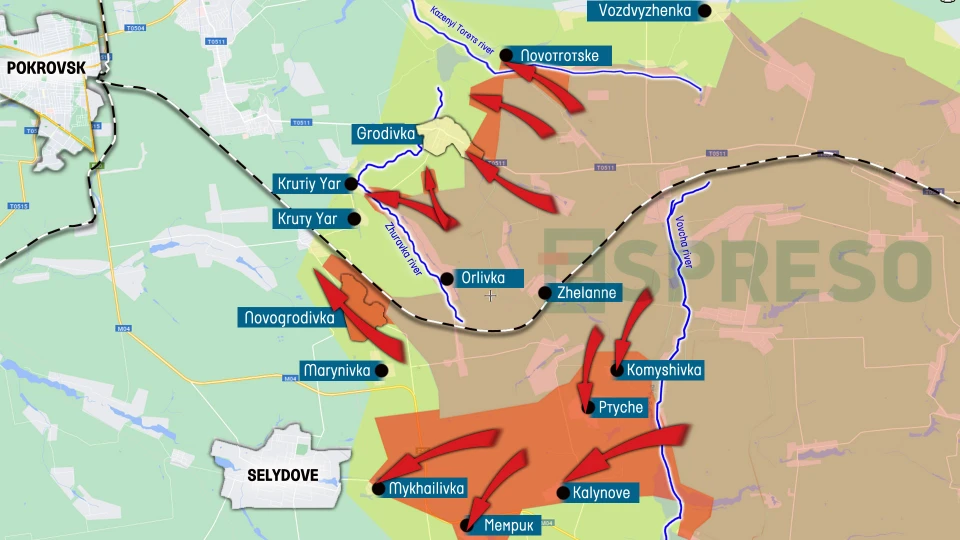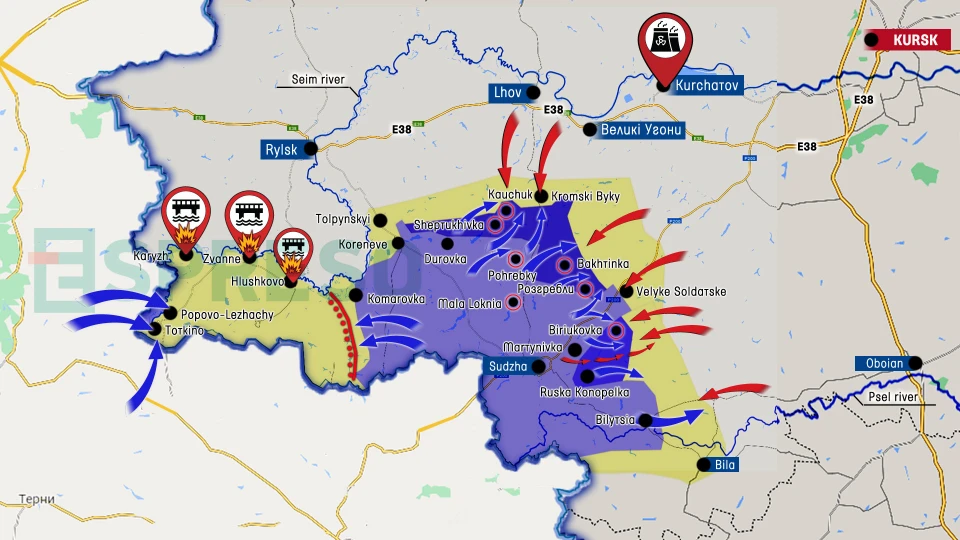
Pokrovsk front, Kursk operation, and Ukraine's ballistic missile: Serhiy Zgurets' column
Russian forces are ramping up pressure in the Pokrovsk direction, while the Ukrainian Armed Forces continue their operations in Russia’s Kursk region. Meanwhile, President Zelenskyy announced that Ukraine has successfully tested its own ballistic missile
Frontline situation
On August 27, there were 184 combat clashes — a significant number, even more than during the Russian attempts to seize Bakhmut. The majority of these clashes occurred in the Pokrovsk direction, where Ukrainian forces repelled 55 Russian attacks. Ukraine's General Staff outlined nearly every settlement in this direction where fighting took place, noting that the heaviest concentration of attacks was near Novohrodivka.

However, this statement leaves the current status of Novohrodivka unclear. We know that the Hrodivka-Novohrodivka line was intended as a critical defensive boundary to slow the Russian advance, with geographical factors in Ukraine's favor. As it stands today, the southern and central parts of Novohrodivka are under Russian control, with a small area still held near the spoil tips. A railway cuts through Novohrodivka, and to the west, there are two spoil tips — one on each side of the railway. Fighting is ongoing in and around these areas.

Since launching operations for Novohrodivka on August 21, Russian forces have advanced 3 kilometers in just a week — a significant gain. Beyond Novohrodivka, there’s another defensive line, and then a stretch of 10 kilometers leading to Toretsk. The railways approaching Pokrovsk and the highways running through it underscore Pokrovsk’s logistical importance. The city is key to supplying both the eastern and southern fronts, and losing it could seriously disrupt Ukraine's logistics.
Is Pokrovsk at risk of falling? It’s too early to say. Russia is currently trying to push southward, securing a flank of their advance, which will take time. As for Pokrovsk itself, one analytical body, the Center for Defense Strategies, predicts that Russian forces may reach Pokrovsk by mid-September but won’t be able to capture it. The upcoming battle for Pokrovsk, they suggest, will likely be the climax of Russia's 2024 southwestern offensive.
Whether this scenario is optimistic or pessimistic is unclear. What’s certain is that Russia’s advance has been bolstered by their numerical superiority and Ukrainian missteps — especially after they took Ocheretyne, a high ground that should have been difficult to penetrate. Its fall, due to rotation issues, has triggered further movement on this front.
There’s now a decision to reinforce the Pokrovsk direction with additional forces, as discussed in a recent Staff meeting. I hope these measures are implemented swiftly. However, it seems the response may be delayed, and there’s a real risk that we’re now trying to patch systemic defense failures in this area with sheer heroism.
Operation in the Kursk region
Ukraine's Commander-in-Chief Oleksandr Syrskyi mentioned yesterday that Russia has deployed around 30,000 personnel to the Kursk region to bolster their forces. This move, naturally, impacts Ukrainian forces' progress. One of the ideas behind the Kursk offensive, as Syrskyi pointed out, was to pull Russian forces away from the Pokrovsk and Kurakhove directions. However, we’re not seeing this yet, as Russia still prioritizes advancing in the Pokrovsk area. But we know that eventually, Russia will feel the impact of the Kursk operation, even if it’s delayed. This could simplify Ukraine's military’s actions in the Pokrovsk direction, similar to what happened in Kharkiv.

To summarize the key developments in the Kursk region, a few areas stand out. In the Glushkovsky district, where bridges have been destroyed, Russian troops are trying to hold the line by building pontoon crossings as replacements. This area spans 40 km in width and 20 km in depth. The Russians are still trying to maintain their defense there, while we’re simply waiting and exhausting their ability to secure this area.
Elsewhere, fighting continues west of Korenevo, a crucial settlement whose capture would allow us to move towards Rylsk and, importantly, control the Rylsk-Lgov highway. There are also ongoing operations towards Lgov and Kursk. Interestingly, in just two weeks, Russian forces constructed 55 km of defensive structures near Kursk, probably preparing for the worst-case scenario.
In addition, there are clashes to the east of Sudzha, where Russia has concentrated a large number of personnel and is attempting to hold the ground. For Ukraine, it’s crucial to expand its flanks, advance east of Sudzha, capture Korenevo, and secure a position in the Kursk region.
Zelenskyy has stated that the Kursk operation is a key part of Ukraine’s victory plan, linked to the second peace summit that Ukraine aims to hold, including representatives from the Russian Federation. This suggests that Ukraine's military leadership will likely align with political goals to maintain a foothold in this area. Balancing forces and resources here is vital, especially compared to other regions where the Ukrainian Armed Forces are active.
The first Ukrainian ballistic missile
Ukrainian President Volodymyr Zelenskyy announced that Ukraine has developed and tested its first ballistic missile. Valentyn Badrak, Director of the Army, Conversion, and Disarmament Research Center, and a military expert, is well-acquainted with those involved in both missile development and Ukraine’s missile program. He explained the project's significance and what technical details can be shared.
"In the spring, we launched a series of powerful strikes on Russian targets. Afterward, the president revealed that one of these missiles would be scaled up for mass production. Essentially, this means that our long-term efforts with cruise missiles have reached their next logical phase. We’re now talking about a ballistic missile, though whether it will be the Hrim or Sapsan is unclear. I think what matters most is that Ukraine has created a ballistic missile, something Russia can’t handle," he emphasized.
Badrak pointed out that we've already seen how Russian air defense systems struggled against American ATACMS tactical missiles, developed in the 1990s.
"Now, Ukraine has its own ballistic missile. Is it old? Is it new? Technologically, I think it's a mix. Remember the Nunn-Lugar CTR program, which seriously weakened us and the industries involved. I was there in 1998 when the last production capacity for strategic ballistic missiles was dismantled, along with other capabilities. But now, trust in us Ukrainians is completely different. Our enterprises have retained significant technology independently, but we still need to accelerate. I firmly believe that developing this ballistic missile requires military-technical cooperation," says Badrak.
The success of this missile program hinges not just on Ukraine's existing, though partly lost, competencies. It also depends on partnering with others for critical components, like fuel or guidance systems, to speed up production.
"We need more than just the creation of a ballistic missile because there's a time gap between creation and mass production. I hope this gap doesn’t exceed a year. To achieve that, this effort must be seriously coordinated — from the President, through the Ministry of Defense, and across all relevant sectors. Additionally, military-technical cooperation must be prioritized, with strategic decisions coming from the President and filtering down to the Defense Minister and lower levels of the industry," the expert concluded.
He underscored that Ukraine currently lacks this system, and it needs to be established. Valentyn Badrak suggests it will be a missile with a range of at least 500 km, capable of carrying a warhead weighing 350-400 kg. He anticipates that by mid-2025, Ukraine will begin serial production of its ballistic missiles.
“And we won’t just scare Russia — we’ll systematically strike it. We don’t need just 10 missiles; we need hundreds, if not thousands, to halt Putin's plague. This is the reality. Without a comprehensive review and restructuring of the process, I stand firm that the Ministry of Defense should take the lead. Fortunately, a specialized deputy minister is already in place, and a support apparatus is being formed. I hope this will all be well-organized. Industry players, like the Ministry of Strategic Industries and Ukroboronprom, must adapt and fall in line with this process,” the expert asserted.
Valentyn Badrak also mentioned the recent presentation of the Palianytsia drone-missile, which he deemed disorganized.
“The presentation was very peculiar; this disarray shows that there are significant flaws in defense industry management that must be addressed immediately. We need a clear system. Historically, missile programs where the president was personally involved in creating a ‘weapon of retribution’ succeeded. The president should be involved — not in technical design, of course, but politically supporting the initiative. The design teams must communicate their needs at critical junctures,” he stressed.
The military expert also sees significant potential in partnering with the American company Northrop Grumman for developing Ukraine’s ballistic capabilities, referencing negotiations that took place in 2022.
“Because the U.S. and the West, in general, aren’t providing us with powerful missiles to strike Russian territory, we must rely on our own weapons. We need to eliminate the platforms currently terrorizing Ukrainian cities and civilians without waiting for anyone’s permission or worrying about ‘red lines’ or escalation. We’ve seen that Putin respects and fears decisive force, like when Turkey downed the Su-24 in 2015, and he quickly backed down,” Valentyn Badrak added.
- News













































